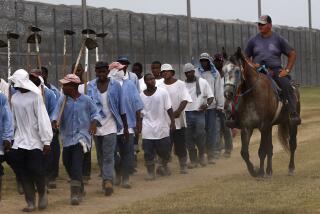U.S. Agency Recommends List of Specific Precautions : Risk of TB Exposure Higher Among Inmates
- Share via
STILLWATER, Minn. — It was bad enough that Antti Haavisto coughed up blood in his prison cell all night. He also had to listen to death threats from neighboring inmates kept sleepless by his ceaseless hacking.
“Hurry up and die,” convicts snarled through the steel bars inside Stillwater Prison in eastern Minnesota. “Shut up or we’ll shut you up.”
Haavisto’s lungs were being consumed by tuberculosis, which remained undiagnosed through 11 visits to sick call over six months in 1982. Prison doctors failed to spot the TB on two X-rays. Although Haavisto was coughing up sputum with the consistency of sludge, the doctors told him he had emphysema or pneumonia and gave him cough drops to ease the hacking.
“I thought I was going to die. I couldn’t get air in, and I couldn’t cough that mud out. I almost drowned twice,” said the wheezing Haavisto, a Finnish immigrant convicted of manslaughter.
“Before I’d go to eat, I tried to cough up enough stuff so I didn’t bother anyone. I was afraid they would hate me and beat me up,” Haavisto, 64, said in an interview.
Still Contagious
Even after Haavisto was diagnosed and released from prison in May, 1983, the airborne germ stalked the Stillwater cellblocks.
One year after Haavisto’s diagnosis, the prisoner in the next cell came down with TB. An outbreak occurred in 1984, when inmates sued the prison for deficient medical care, and another rash of infections hit in 1986, when the entire prison was finally tested.
Ultimately, one-third of the 1,200 inmates and at least five guards were infected.
Tuberculosis is a bacterial lung disease once known as consumption because it eats away lung tissue. Scientists estimate that 10 million Americans are infected, but the vast majority will never get the disease.
TB is far worse in crowded prisons. Lawyers and inmate advocates say TB outbreaks show what can happen when a contagious disease infects a closed environment with antiquated ventilation systems and inattentive medical watchdogs.
The incidence of TB among prisoners is more than triple the rate of those not in jail, according to a May report by the federal Centers for Disease Control. In New Jersey, the rate is 11 times higher for inmates; in California, six times higher. New York prisons had a sevenfold increase in the disease in the 10-year period ending in 1986.
The CDC recommended these corrective measures for prisons: TB tests at least once a year, quick X-rays for inmates showing symptoms and isolation of those infected.
In Minnesota, federal Judge Diana Murphy said the handling of the epidemic by prison officials and the state Department of Health “evidenced a lack of care or reckless disregard for the medical needs of inmates.”
Conditions Improved
In January, five years after the lawsuit was filed, she ruled that conditions had improved and there was no need to order corrective actions.
Nevertheless, she severely criticized prison administrators, saying they “passed off responsibility to (the) Department of Health, which assigned responsibility to the doctors, who denied any role in managing the crisis other than (in) providing primary care.”
“It was a shocking case of negligence,” said Stephen Miles of the University of Chicago’s Center for Clinical Medical Ethics. “Prisoners were not only incarcerated but negligently exposed to a contagious disease.”
“The prison became a pest hole of tuberculosis infection. Not only was there neglect, prison officials turned a blind eye to known facts. There was recklessness,” said Arlo Vandevegte, attorney for the inmates who sued the state.
Haavisto apparently brought the TB with him into Stillwater. On his trips to sick call, he even suggested the medical staff check for TB.
“I told them I think I got some real bad problem. I couldn’t talk. I couldn’t even make a phone call it was so bad,” Haavisto said. “I said I got to get out of this hole or I’m going to die in here.”
Inmate Tony DeGidio contracted TB during the epidemic. His father caught it when he came to the prison to visit Tony.
“You’re trapped. You don’t have a way out,” DeGidio said. “We used to tell the guards to do something. This guy’s got a problem. Treat it or we’re going to treat it our way. Eliminate him.”
Prison officials say treatment and tracking have improved.
“We don’t have those problems now,” said LeRoy Siegel, executive assistant to Stillwater’s warden. “We responded the way the so-called experts told us to.”
More to Read
Sign up for Essential California
The most important California stories and recommendations in your inbox every morning.
You may occasionally receive promotional content from the Los Angeles Times.










